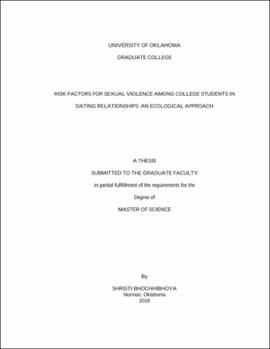| dc.description.abstract | Introduction: Amidst the environment of autonomy from parental authority and peer pressure of college life, college students are vulnerable to sexual violence in dating relationships. The American College Health Association (ACHA) now recognizes sexual and dating violence as a serious public health issue that should be addressed by multi-level interventions. According to ACHA 2015, almost 9.5% of undergraduates are documented to have experienced unwanted sexual contacts while 4.1% of undergraduates have experienced attempted or completed rape in past 12 months of college life. With regards to the intimate partner relationship, nearly 11% of females, 6% of males and 17% of transgender have experienced violence (emotional, sexual and physical) in past 12 months. Sexual violence has been documented to be associated with long-term health risks like substance abuse, unintended pregnancy, and chronic mental illness as well as physical injuries including broken bones, vaginal trauma and bruises. Given that the prevalence is high among college students and is majorly perpetrated by their dating partners, the purpose of the study was to explore the risk factors of sexual violence victimization among college students in dating relationships using ecological model.
Methods: Validated and reliable tools used in previous studies were used to examine risk factors related to four levels of the ecological model; individual, relationship, community, and societal level, among college undergraduates students aged 18-24 years studying at the University of Oklahoma, Norman Campus. Reliability was assessed using a Cronbach’s alpha and construct validity was evaluated using confirmatory factor analysis for our study population. Participants were recruited to take an online survey circulated through mass emails and emails from the Gender and Equality Center. The circulated survey tool included domains including sexual identity, gender identity, place of residence, inclusion in social organizations, experience of child sexual abuse, characteristics of their dating relationship while in college, sexual assertiveness, their parental involvement, peer deviance, involvement in sexual risk behaviors, social support and perceived discrimination related to four levels of the ecological model.
Results: Approximately 35% of the sample reported experiencing sexual violence in dating relationships. Three out of 10 college students experienced attempted rape while two out of 10 college students had been raped by their dating partners while in college. Significant differences in sexual violence victimization were seen between male and female students for all the types of sexual violence while a difference was reported between heterosexual and LGBTQ students in experiencing at least one type of sexual violence and unwanted sexual contacts. Most of the instrument scales were found to be valid and reliable. Logistic regression results revealed that being a senior, having higher sexual assertiveness, hooking up and perceived discrimination are significant risk factors for experiencing sexual violence by college students in dating relationships while in college. Female gender and having low sexual assertiveness related to the individual level of the ecological model and higher frequency of hooking up related to the relationship level of the ecological model increased the log counts of unwanted sexual contacts, attempted rapes and completed rapes in college students in dating relationships. No constructs related to community level of the ecological model was found to have a significant association with sexual violence. Participants’ perceived discrimination was found to increase the incidences of ever experiencing sexual violence while it is significantly associated with decreasing a number of completed rape.
Discussion: The constructs related to the individual, relationship and societal level of the ecological model were found to have the significant association with unwanted sexual contacts, attempted rapes and completed rapes among college students in dating relationships. Participants’ gender, sexual assertiveness, and engagement in hooking up were found to be most important risk factors for all kinds of sexual violence occurring while in college.
Conclusion: The findings highlight the importance of the use of the ecological model in discovering the variables related to sexual violence victimization among college students in dating relationships. Given the need for sexual violence intervention and prevention on college campuses, consideration of these risk factors while formulating the programs is essential. | en_US |
